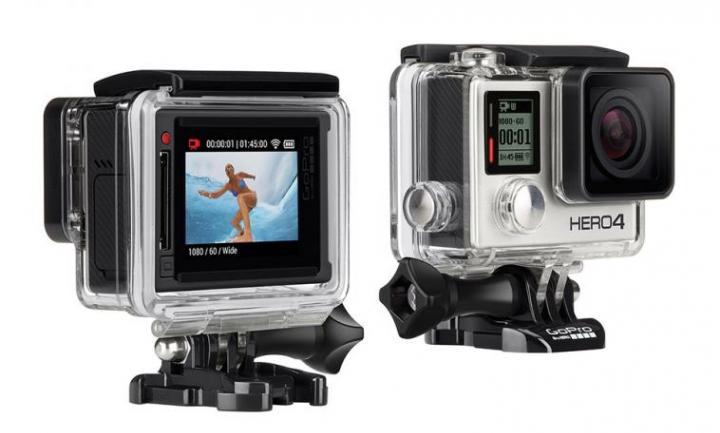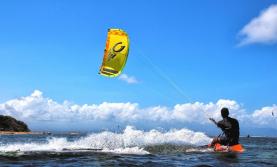Gopro Hero 4 Silver
Image

Specs
Max Video Resolution
Megapixels
Weight (KG)
Battery Life
Body Size
Camera Features
Accessories In Box
waterproof housing, 2 adhesive mounts (one flat and one curved), skeleton and touch back doors, horizontal and vertical quick release buckles with a small locking plug, three way pivot arm
When you buy the GoPro Hero 4 Silver you will not just get the camera but also a waterproof housing (131 feet depth), 2 adhesive mounts (one flat and one curved), skeleton and touch back doors, horizontal and vertical quick release buckles with a small locking plug and a three way pivot arm.
The charger for the camera is not given, but instead a Mini-USB cable is provided that can connect to a computer or wall adapter for charging. There also isn’t a microSD card included, so you will have to buy one on your own.
The Silver model has the same dimensions as the Hero3/3+, so you can still use the same housings, but what has changed is the battery location and type.
The battery compartment has been redesigned and the batteries do not slide in the back anymore but are located at the bottom. While this makes it easier to change the batteries, you will also have to buy new ones that cost $20 or £16 each.
On the left side of the camera is where the Micro-HDMI, Mini-USB ports and a microSD slot (up to 64 GB) are located, with an easily removable protecting cover. The Mini-USB port helps you charge the camera and transfer your files from the microSD card, but you can also attach a 3.5mm stereo mic cable if you want.
Located next to the touchscreen is the Hero port, which will let you connect the Battery BacPac, though the screen will get blocked if you do so.
While the camera's button layout is still the same, the Wi-Fi power button on the right side has now become a Highlight Tag button. Finding the one ‘wow’ moment in hours of recorded video can be quite cumbersome and difficult, but with this new function it has been made much easier. When recording with the Hero 4 Black, you can press the button immediately after you feel you’ve successfully recorded that ‘wow’ moment and so it gets tagged for you to find later.
When not recording, the same button can be used to control the settings menus. The new context sensitive menu system displays the settings for the mode that you are on, when you press it. For instance, if you are using the video capture mode, you will only get the settings options for video.
This eliminates the need to press endless buttons and reach the desired setting, like you had to in the previous camera models. While this make take some adjusting to, it is a much needed and simpler function that will enhance the experience of using your GoPro camera.
As previously discussed, the newest addition to the list of GoPro features is the 1.5-inch touchscreen on the camera’s back that helps you in changing modes and settings, too. Just swipe from right to left to select your mode and swipe up from down to change your mode settings. The touchscreen also lights up when it is dark and lets you review everything that you have recorded.
You can also connect the camera to your mobile phone devices using its Wi-Fi connectivity. iOS, Android and Windows Phones are supported for the mobile app. There is also Bluetooth connectivity so you can use a Pebble watch to regulate the camera. And you can buy the LCD BacPac and attach it to the camera’s back.
The camera's Wi-Fi lets you connect to GoPro’s wireless remote that has the same function as the camera’s front LCD and three-button controls. It also supports tagging.
Wi-Fi is a major reason for your GoPro camera’s battery to drain out faster, so if you aren’t using it making sure that you keep it switched off. The battery life of the camera is not very good as compared to other sports cameras in the market, like the iOn Air Pro 3 or Drift Ghost-S.
When recording at such high frame rates, the battery life becomes shorter and with other features like burst shooting and high speed time lapse, the battery takes a toll. This is basically the price that you have to pay for the small size and lightness of the GoPro camera.
On an average, when you are recording continuously videos with 1080p at 60fps in Protune mode and no Wi-Fi, the GoPro Hero 4Silver’s battery should last you about 1 hour and 30 minutes.
With the amazing resolution and frame rate combinations, there are many possibilities for recording videos with this GoPro camera. You can also experiment with stills and time lapse options.
Though you can capture videos with up to 4K resolutions, the most important settings are 1080p at 60fps, 960 at 100fps and 720p at 120fps. But, if you choose 30fps for 1080p or 60fps for 720p, you can also record video and capture time-lapse photos at the same time with intervals of 5, 10, 30 or 60 seconds.
Another important feature is the Protune mode. It not just lets the camera record at its highest bit rate of 45Mbps, but also set color to GoPro's color profile or Flat. You can also select an ISO sensitivity limit of 400, 1600 and 6400 for video and 100, 200, 400 and 800 for photos, choose a white balance for the lighting conditions, regulate the shutter speeds for the newly added Night Photo and Night Lapse modes and alter sharpness and exposure (+/-2EV).
That is a lot more control over the setting than most action cameras allow. But if you want to have complete manual control, then that isn’t possible. For instance, you cannot adjust the shutter speeds to 1/25th or 1/10th of a second and they can only be regulated to 2, 5, 10, 15, 20 or 30 seconds.





